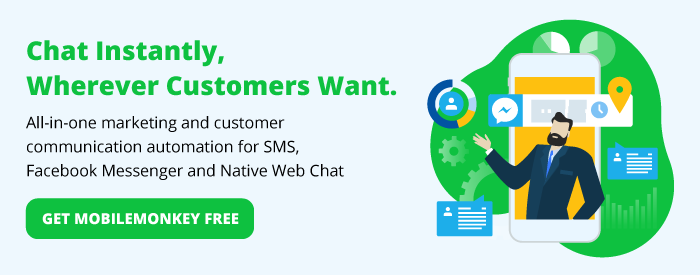The biggest difference between doing customer service on social media and through phone, email, or live chat is that on social media, you have an audience.
Your customers, prospects and everyone else can see how you respond or how you don’t respond — both of which can speak volumes.
For example, there are countless examples of brands going above and beyond to deliver an amazing experience through social media, like the time that Morton’s delivered a steak to a business traveler in the airport because of a tweet.
In this post, we’re sharing seven best practices to help you take your social media customer service to the next level:
- Hang out where your customers are
- Listen first, type second
- Know when to take an issue offline
- Speed matters
- Invest in people and training
- Build a social media playbook
- Create a weekly social media customer service report
7 Social Media Customer Service Best Practices
1. Hang out where your customers are
This seems obvious, but it’s easy to overlook. Part of delivering a great customer experience is making it easy for people to get support when and where they need it.
You might use different channels than other brands, and you don’t need to be active on every channel.
For example, if you have an e-commerce shop that sells shoes mainly to Gen Zers, you might want to spend all of your time listening and replying to fans and customers on TikTok and Instagram.
On the flip side, if you sell tours to senior citizens, Facebook might be your primary platform.
If you stick around where your followers congregate, you’ll have an easier time collecting customer reviews or references.
Customer references are integral to brand marketing, and you’ll want to utilize the most effective customer reference gathering techniques to convince your followers to provide them.
2. Listen first, type second
You have two ears and one mouth for a reason.
Some of the biggest brand social media mistakes happen because the social media manager didn’t take the time to read the room or understand the context of the problem.
Pro tip: This is especially important if the post or tweet has any hashtags. Make sure you understand the hashtag before you use it. Just ask DiGiorno Pizza what happens when you hijack a hashtag.
Once you understand the context, you want to respond in public and show that you care and are listening. This requires empathy.
You can de-escalate some gnarly situations with an empathetic reply. On the flip side, you can make an issue worse if you come across as robotic, copy and paste the same script over and over, or reply once and fall off.

3. Know when to take an issue offline
Just because a customer brings up an issue online doesn’t mean you need to solve the entire thing online.
There are some things that you should acknowledge online but then take offline ASAP to resolve.
For example, if resolving the issue involves the need for the customer to share personal information, you can guide them to a DM, email, phone call through a business phone system, or utilize live chat. After all, you don’t want a customer sharing their credit card details or their address with everyone on Twitter.
4. Speed matters
Did you know that 40 percent of customers expect a response on social media within one hour?
With email, you can get away within 24-hour response times. However, when you have someone tweeting at your brand, and you wait 24 hours to respond, the optics are bad. Twitter moves so fast that if you aren’t replying right away, you risk looking out of touch or like you don’t care.
5. Invest in people and training
Customer service on social media is more nuanced and difficult than traditional support. Because of this, it requires different skills.
There are two different ways to approach it. Both can work.
- Put a marketing or communications professional in charge of social media customer service, and then train them on the ins and outs of your product.
- Train some folks on your customer support team on communication and social media best practices.

6. Build a social media playbook
One of the best ways to train and uplevel your social customer service team is to build a playbook. Here are some of the things you should include:
- Social media branding and messaging guidelines
- Some templates for how to respond to common questions
- A crisis communication plan
The last one is key, as all it takes is one or two angry customers to create a PR nightmare. Just ask United Airlines about what can happen if you break a musician’s guitar (i.e., this video has more than 20 million views) or drag a paying customer off a plane. United has provided several examples of what not to do.
Have a communication plan in place so that if an issue arises, you can triage, reply, and handle it quickly.
7. Create a weekly social media customer service report
Just like with phone, email, and live chat support, you should track actionable social media metrics, like overall volume, the number of replies, average time to resolution, brand sentiment, etc., on a weekly basis.
This will allow you to gauge customer satisfaction and spot patterns over time.
Pro tip: Use JotForm’s new JotForm Report Builder to review top service requests for trends or recurring issues. This puts all information into a handy report you can share with your entire team.

Another advantage of creating a weekly report is that it allows you to make informed staffing decisions. If you notice a 250% increase in activity on Instagram, you might need to hire and onboard another rep to help with the increased volume.
Support Through Social Media
Doing customer service on social media requires more nuance than traditional support channels such as phone, email, and live chat.
Before you dive in, it’s important to understand the ins and outs of each social media platform and have a game plan for training your team.
About the Author
Briana is the partnership marketing manager at JotForm, where she spends her time building relationships with other exciting SaaS companies. When she’s not in the office, she loves going to a yoga class and running along the Embarcadero in San Francisco.

Important Next Steps
- Create a free chatbot today with the new Free Forever Customers.ai Stay Connected special edition.
- Talk and learn about chatbots with other enthusiasts. Join Customers.ai Island, a Facebook group of over 35k marketers and entrepreneurs that are ready to support you.
- Advance your marketing performance with Chatbot University, a free chatbot tutorial and training area for chat marketers.

